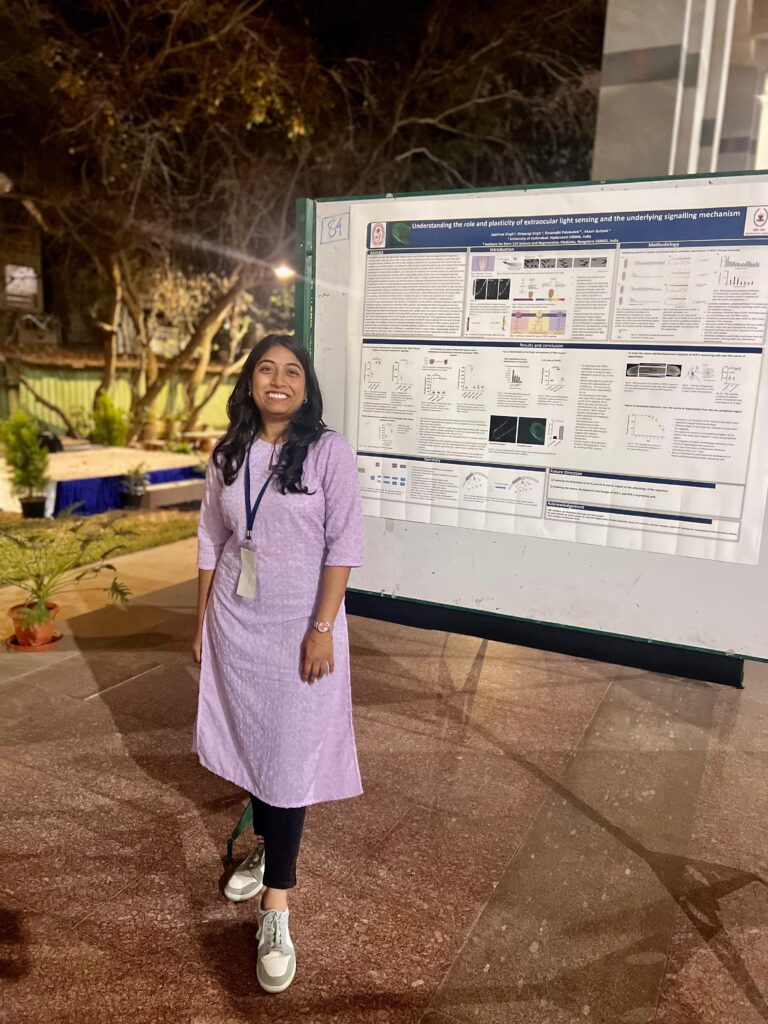Jayshree Singh is a graduate student working on planaria in the lab of Akash Gulyani at the Central University of Hyderabad.
Let’s start with an intro to the research presented in your winning poster.
Our capacity to perceive our environment hinges on the intricate coordination between our eyes and brain. While humans can see colors like red, blue, and green, there are other types of light that we cannot detect. One such kind is UV light, which consists of rays like UV-A, UV-B, and UV-C, based on their wavelengths.
I study light sensing in Planaria, a flatworm. Most organisms, including us humans, rely on our eyesight to sense light. However, we found something exciting and different in planaria. These worms also have eye-independent light-sensing systems in addition to eye-brain-based light sensing. This means that even without an eye, they can sense and respond to light!
What do you mean by eye-independent light-sensing systems? What was it that you observed in these worms?
We found that when you remove the head of these worms, they have the remarkable ability to detect and react to UV light. This means that apart from the eye, they also have another sensory system that detects these UV rays. Additionally, we recognized distinct differences between detecting UV-A and UV-B light. Even though there isn’t much difference in the wavelengths between UV-A and UV-B rays, the sensory system downstream acts very differently in these worms. This discovery sheds light on a unique light-sensing mechanism within the worm’s body and identifies specific molecular components involved.
How does this happen? How are these two mechanisms different?
The UV-A light detection goes through a unique pathway that we discovered in our lab. Conversely, UV-B light is perceived as a harmful stimulus, and this is sensed through an entirely different pathway. This worm with a simple brain that has just two cephalic ganglia is able to distinguish light of different wavelengths. It is surprising and amazing how even a rudimentary organism like planaria exhibits such complexity.
This is a really interesting study!
Yes! These worms have survived the course of evolution for a long time, and are photo aversive and dark dwelling. This raises the question of how they are able to survive in cases where they lose their head or eyes. Because they will have to survive till their eye gets regenerated. So, there should be some mechanism by which they survive such situations. Now we know the sensory mechanisms that help them do this. So this study becomes interesting in the context of their survival and physiology as well.
Planaria is often studied for its insane ability to regenerate. This is a new angle of study. How did your lab start working on this? What’s the one thing about your project that keeps you excited?
Initially, when the lab started, the main question was to understand how planaria senses light or how would it respond to different wavelengths of light. The lab started asking these simple yet critical questions. And what we ended up finding was truly fascinating. This was the starting point. Then we figured out the headless worms were responding to UV light.
Imagine coming across a discovery that a headless organism can detect and avoid light, particularly within a specific range of wavelengths. This sparked my curiosity and made me wonder why and how this happens in such a simple organism. I also realized that not only does this project provide insights into evolutionary processes and the organism’s survival physiology, but it also has potential implications for optogenetics at a translational level. All of these factors motivated me to undertake this project. Uncovering new findings about planarian biology keeps me excited and driven.
Shifting gears a bit- the InSDB conference had 150+ posters on display, along with many talks. Which among these stood out to you?

Each presented poster must have been of considerable value, though as a presenter myself, I regret not being able to visit every display. Attending talks delivered by esteemed speakers was rewarding for me. Their presentations were interesting and educational, covering a wide range of topics. These talks kept me updated on developments related to my work and expanded my knowledge across different fields. I particularly enjoyed listening to speakers like Sunil Laxman, Hiroshi Hamada, Shubha Tole, and Claude Desplan, whose talks were stimulating and motivating. Among them, the presentation by Prof. Masatoshi Takeichi left a lasting impression on me. Hearing him discuss the discovery of cadherin was truly mind-blowing, as it felt like being transported back in time to witness a pivotal moment in scientific history. His talk highlighted the significance of a researcher’s approach, giving me valuable insights that I aim to use in my future pursuits.
Were you able to interact with these speakers? What are some learnings and takeaways you gained from InSDB24?
Yes! The most exciting part about the conference was the opportunity for participants to connect with the speakers and among themselves. As a researcher studying planaria, I’ve always had fascinating unanswered questions about how certain systems work in these organisms. The conference enabled me to interact with experts who work on similar topics. These interactive sessions encouraged an open-minded approach and improved my understanding of scientific principles, allowing me to ask new questions and develop effective strategies to answer them.
That’s good to hear. What is next for you?
As a third-year PhD student, I hope to attend more conferences and connect with others to explore new ideas. I see myself sharing my research, and giving talks. My ultimate goal is to pursue this path with determination, leading to the successful completion of my PhD.
Thank you, Jayshree, and all the best!





